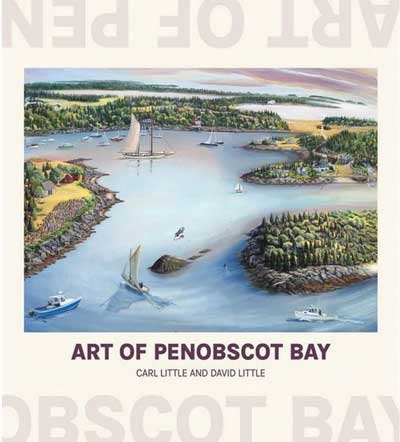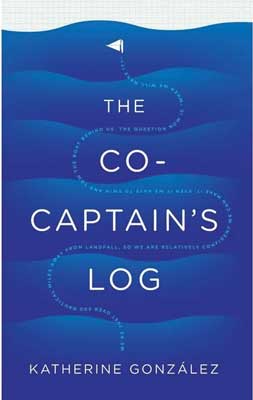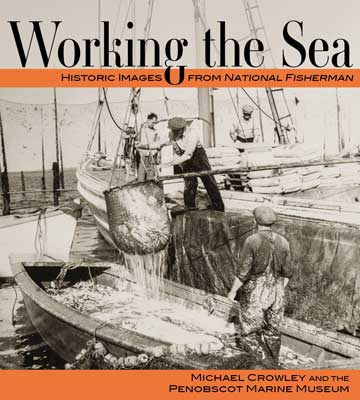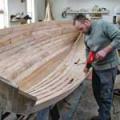Books for these long winter nights
By The Editors

Art of Penobscot Bay
by Carl Little and David Little
Islandport Press, 2023, 142 pages, $34.95.
Readers of this magazine will immediately recognize the name of author Carl Little, our longtime contributing editor whose stories in each issue delve into the lively and always evolving art landscape of Maine. In Art of Penobscot Bay, he and his brother, David, have created a noteworthy and colorful in-print gallery of works inspired by the sea, islands, and coast of a single body of water that has delighted sailors, sports, rusticators, and residents alike for centuries. The authors chose to include more than 120 artists and their works, all inspired by a dramatic sense of place. They focus first on “Yesterday,” the 19th and 20th century, and then turn their attention to “Today,” the 21st century for the remainder of their work. It’s a book you’ll keep handy and want to pick up time and again, as you might drop in to visit a favorite museum or gallery.

Ship of Lost Souls: The Tragic Wreck of the Steamship Valencia
by Rob Scher
illustrated by Molly Dumas; Lyons Press, 2024, 256 pages, $32.95.
illustrated by Molly Dumas; Lyons Press, 2024, 256 pages, $32.95.
The year was 1906, when the steamship Valencia set out on a January run from San Francisco, California, bound for Seattle, Washington. It would turn into one of the saddest voyages to end in what became known as the Graveyard of the Pacific. In deteriorating weather and miles off course because of an inexperienced captain and a poorly understood ocean current, the Valencia struck a reef off of Cape Beale, on the remote and rugged coast of southwest Vancouver Island. With the ship’s hull ripped open from pounding on rocks, rescue efforts went badly. A green crew had little experience with the ship’s lifeboats and other safety gear, and conditions quickly worsened. Women and children, many of whom were lashed to the rigging in order to save them from crashing waves, all were lost. In the end only 37 passengers survived. Ship of Fools is a riveting read about the rigors of putting to sea and the consequences of doing so unprepared.

The Co-Captain’s Log
by Katherine González
Posada Publishing, 2024, 375 pages, $24.99.
Sailors would understand if Katherine and Andrés González had decided to call it quits. At the outset, their dream voyage didn’t go so well. On a run from the Strait of San Juan de Fuca to San Francisco, they found themselves in a rising gale, and while shortening sail, their 34-foot Pacific Seacraft was hit by a wall of water that knocked Andrés partially overboard and slammed Katherine into the side of the cockpit, breaking her leg. Still, three months later, they were at sea again, bound first for Mexico, then French Polynesia and finally New Zealand. The Co-Captain’s Log chronicles it all, the good and bad, with tasty boat recipes thrown in to boot. Sailors like their sea stories, and González spins a good one. She even includes links to an online multimedia treasure trove of maps, photos, and videos of the adventure.

Working the Sea
by Michael Crowley and the Penobscot Marine Museum
Islandport Press, 2024, 160 pages, $36.95.
Islandport Press, 2024, 160 pages, $36.95.
Working the Sea focuses on the vessels and fishermen that have been at the heart of America’s fishing industry. It includes more than 100 photos from National Fisherman, a Maine-based magazine for commercial fishing, and its predecessor Atlantic Fisherman. Both publications documented the lives of those who work at sea for more than a century. Their pre-digital photo collection, consisting of more than 3,000 images, was donated to the Penobscot Marine Museum archive. Photos for the book highlight the changes that took place in America’s fisheries during the 19th and 20th centuries. Author Michael Crowley spent years working on halibut longlines in the Gulf of Alaska and the Bering Sea. He has also been a contributing editor and field editor for National Fisherman, and he’s written for Workboat magazine, specializing in stories about new vessel construction and gear. Working the Sea will entertain and inform readers interested in New England history, shipbuilding, commercial fishing, and, of course, historical photographs. To order a copy of the book directly from the Penobscot Marine Museum, visit bit.ly/3Cmsu2R.

The Last Days of the Schooner America: A Lost Icon at the Annapolis Warship Factory
by David Gendell
Lyons Press, 2024, 347 pages, $34.95.
Lyons Press, 2024, 347 pages, $34.95.
The schooner America is perhaps the most famous racing sailboat in the world. Her place in history was earned on one day in England, in a race around the Isle of Wight. The rest of her story is relatively unknown, but is brought to life in this very thoroughly researched and informative history by David Gendell. He writes about what happened before that day on the Solent, and in greatest detail about the boat’s history after winning the Hundred Guineas Cup, later named The America’s Cup. From racing in the Mediterranean to a Civil War blockade runner to the U.S. Naval Academy, the America remained in service until the start of World War II. It’s an important story for all maritime historians and sailing enthusiasts. In the end, America’s demise was not all that different from other high-performance purpose-built racing machines. However, the details of how it all came to pass are captivating. If you ever visited The Chart House restaurant in Annapolis, Maryland, you were very close to the final resting place of the famous schooner, and many locals claim to have a few pieces of the yacht at home on their mantels. Gendell has penned a great book to read by the fire on a cold winter’s day. Perhaps you can even hear the creaking of the timbers from the weight of the snow on the shed that covered the hull in its final days.

Loving the North Woods: 25 Years of Historic Conservation in Maine
by Karin R. Tilberg
Down East Books, 2024, 206 pages, $19.95.
Down East Books, 2024, 206 pages, $19.95.
Over the course of a quarter century, roughly from 1990 to 2015, a multitude of public and private efforts transformed Maine’s North Woods as ownership of the land went from primarily paper companies to an array of public and private entities committed to their long-term conservation. Over that period, the amount of land in public ownership or somehow protected went from 5 percent of the state to 20 percent—a four million-acre shift. Witnessing this remarkable sea change and the many individuals involved was Karen R. Tilberg, president of the Forest Society of Maine. It’s a story she recounts in her book, Loving the North Woods—an informative tale and a must read for anyone interested in how the deals got done.
✮
Related Articles
Share this article:
2023 Maine Boat & Home Show

Join Us for the Maine Boat & Home Show!
Art, Artisans, Food, Fun & Boats, Boats, Boats
August 11 - 13, 2023 | On the waterfront, Rockland, Maine
Click here to pre-order your tickets.
Show is produced by Maine Boats, Homes & Harbors magazine.















